Introduction to PHP form elements: input field tag
Form
In this chapter we focus on introducing the input field tag .
Input field tag
Input field tag is one of the most commonly used tags in forms. Commonly used input field tags include text boxes, buttons, radio buttons, checkboxes, etc.
The syntax format is as follows:
<form> <input name="file_name" type="type_name"> </form>
The parameter name refers to the name of the input domain; the parameter type refers to the type of the input domain. The following types of input fields are provided in the
type attribute values, examples and explanations:
1. text
Example:
<input name="user" type="text" value="饮料" size="12" maxlength="1000" >
Instructions: name is the name of the text box, value is the default value of the text box, size refers to the width of the text box (in characters), maxlength refers to the text box The maximum number of input characters.
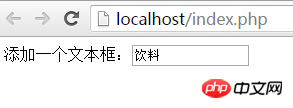
2. password
Example:
<input name="pwd" type="password" value="123456" size="8" maxlength="16" >
Description: Password field, the user is in this text box The input characters will be replaced and displayed as "*" to maintain confidentiality.
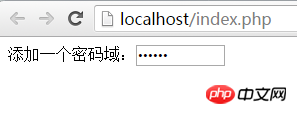
3. file
Instance:
<input name="file" type="file" enctype="multipart/form-date" size="12" maxlength="200" >
Description: File field, when file is uploaded , can be used to open a modal window to select files. Then upload the file to the server through the form, such as uploading a word file, etc. It must be noted that when uploading files, you need to specify the attributes of the form enctype="multipart/form-date" to achieve the upload function.
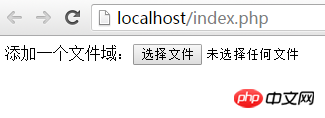
4. radio
Example:
<input name="sex" type="radio" value="男" checked>男 <input name="sex" type="radio" value="女" >女
Description: Radio button, used to set a group The user can only select one item. The checked attribute is used to set the radio button to be selected by default.
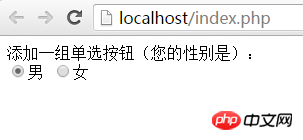
5. checkbox
Example:
<input name="goods" type="checkbox" value="book" checked="checked" >图书 <input name="goods" type="checkbox" value="fruits" >水果 <input name="goods" type="checkbox" value="food" >食品
Description: Check box, allowing the user to select multiple options. The checked attribute is used to set the single checkbox to be selected by default. For example, when collecting personal information, you are required to make multiple choices among the options of personal preferences.
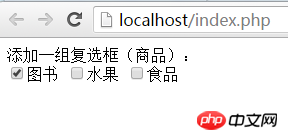
6. submit
Instance:
<input name="submit" type="submit" value="提交" >
Description: Submit the content in the form to the server.
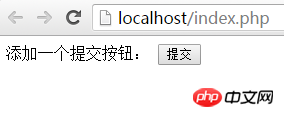
7. reset
Example:
<input name="reset" type="reset" value="重置">
Description: Clear and reset form content, used to Clears the contents of all text boxes in the form and returns the selection menu items to their initial values.
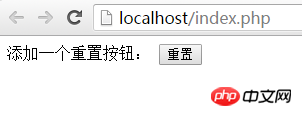
8. button
Example:
<input type="button" value="Hello world!">
Description: The button can trigger the action of submitting the form. When the user needs to modify the form, the form can be restored to its original state, and it can also play other roles according to the needs of the program. Ordinary buttons are generally used with JavaScript scripts for form processing.
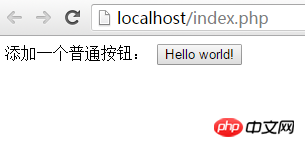
9.hidden
The example is as follows:
<input type="hidden" name="id">
Description: Hidden domain, used in Submit the variable value implicitly in the form. Hidden fields are invisible to users on the page. The purpose of adding hidden fields is to collect or send information in a hidden way. When the viewer clicks the "Send" button to send the form, the information in the hidden field is also sent to the processing page specified by the action.
The above is an introduction to the input field mark and an example of the type attribute of . Friends need to memorize this and practice more operations, because the form will be very useful in future development. .
The above is the detailed content of Introduction to PHP form elements: input field tag . For more information, please follow other related articles on the PHP Chinese website!

Hot AI Tools

Undresser.AI Undress
AI-powered app for creating realistic nude photos

AI Clothes Remover
Online AI tool for removing clothes from photos.

Undress AI Tool
Undress images for free

Clothoff.io
AI clothes remover

Video Face Swap
Swap faces in any video effortlessly with our completely free AI face swap tool!

Hot Article

Hot Tools

Notepad++7.3.1
Easy-to-use and free code editor

SublimeText3 Chinese version
Chinese version, very easy to use

Zend Studio 13.0.1
Powerful PHP integrated development environment

Dreamweaver CS6
Visual web development tools

SublimeText3 Mac version
God-level code editing software (SublimeText3)

Hot Topics
 PHP 8.4 Installation and Upgrade guide for Ubuntu and Debian
Dec 24, 2024 pm 04:42 PM
PHP 8.4 Installation and Upgrade guide for Ubuntu and Debian
Dec 24, 2024 pm 04:42 PM
PHP 8.4 brings several new features, security improvements, and performance improvements with healthy amounts of feature deprecations and removals. This guide explains how to install PHP 8.4 or upgrade to PHP 8.4 on Ubuntu, Debian, or their derivati
 7 PHP Functions I Regret I Didn't Know Before
Nov 13, 2024 am 09:42 AM
7 PHP Functions I Regret I Didn't Know Before
Nov 13, 2024 am 09:42 AM
If you are an experienced PHP developer, you might have the feeling that you’ve been there and done that already.You have developed a significant number of applications, debugged millions of lines of code, and tweaked a bunch of scripts to achieve op
 How To Set Up Visual Studio Code (VS Code) for PHP Development
Dec 20, 2024 am 11:31 AM
How To Set Up Visual Studio Code (VS Code) for PHP Development
Dec 20, 2024 am 11:31 AM
Visual Studio Code, also known as VS Code, is a free source code editor — or integrated development environment (IDE) — available for all major operating systems. With a large collection of extensions for many programming languages, VS Code can be c
 Explain JSON Web Tokens (JWT) and their use case in PHP APIs.
Apr 05, 2025 am 12:04 AM
Explain JSON Web Tokens (JWT) and their use case in PHP APIs.
Apr 05, 2025 am 12:04 AM
JWT is an open standard based on JSON, used to securely transmit information between parties, mainly for identity authentication and information exchange. 1. JWT consists of three parts: Header, Payload and Signature. 2. The working principle of JWT includes three steps: generating JWT, verifying JWT and parsing Payload. 3. When using JWT for authentication in PHP, JWT can be generated and verified, and user role and permission information can be included in advanced usage. 4. Common errors include signature verification failure, token expiration, and payload oversized. Debugging skills include using debugging tools and logging. 5. Performance optimization and best practices include using appropriate signature algorithms, setting validity periods reasonably,
 PHP Program to Count Vowels in a String
Feb 07, 2025 pm 12:12 PM
PHP Program to Count Vowels in a String
Feb 07, 2025 pm 12:12 PM
A string is a sequence of characters, including letters, numbers, and symbols. This tutorial will learn how to calculate the number of vowels in a given string in PHP using different methods. The vowels in English are a, e, i, o, u, and they can be uppercase or lowercase. What is a vowel? Vowels are alphabetic characters that represent a specific pronunciation. There are five vowels in English, including uppercase and lowercase: a, e, i, o, u Example 1 Input: String = "Tutorialspoint" Output: 6 explain The vowels in the string "Tutorialspoint" are u, o, i, a, o, i. There are 6 yuan in total
 How do you parse and process HTML/XML in PHP?
Feb 07, 2025 am 11:57 AM
How do you parse and process HTML/XML in PHP?
Feb 07, 2025 am 11:57 AM
This tutorial demonstrates how to efficiently process XML documents using PHP. XML (eXtensible Markup Language) is a versatile text-based markup language designed for both human readability and machine parsing. It's commonly used for data storage an
 Explain late static binding in PHP (static::).
Apr 03, 2025 am 12:04 AM
Explain late static binding in PHP (static::).
Apr 03, 2025 am 12:04 AM
Static binding (static::) implements late static binding (LSB) in PHP, allowing calling classes to be referenced in static contexts rather than defining classes. 1) The parsing process is performed at runtime, 2) Look up the call class in the inheritance relationship, 3) It may bring performance overhead.
 What are PHP magic methods (__construct, __destruct, __call, __get, __set, etc.) and provide use cases?
Apr 03, 2025 am 12:03 AM
What are PHP magic methods (__construct, __destruct, __call, __get, __set, etc.) and provide use cases?
Apr 03, 2025 am 12:03 AM
What are the magic methods of PHP? PHP's magic methods include: 1.\_\_construct, used to initialize objects; 2.\_\_destruct, used to clean up resources; 3.\_\_call, handle non-existent method calls; 4.\_\_get, implement dynamic attribute access; 5.\_\_set, implement dynamic attribute settings. These methods are automatically called in certain situations, improving code flexibility and efficiency.






